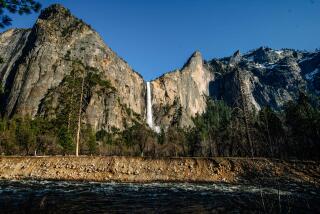Rediscovering the Path to Yosemite : Couple Retrace Route of First White Man to See Valley
- Share via
YOSEMITE NATIONAL PARK — The 34-year-old trailblazer came from a family of adventurers that California historians call the “pioneers among pioneers,” but few know by name the man who discovered Yosemite Valley.
“He was a gentleman among the mountain men of the time,” said Linda Lee, one of two Southern California outdoor enthusiasts who recently retraced the 1833 route of Capt. Joseph R. Walker across the Sierra Nevada to the precipitous ledge of Yosemite’s spectacular granite chasm.
“He didn’t cuss, didn’t gamble and was only a ceremonial drinker,” added Lee in obvious admiration of the explorer.
Lee, a 31-year-old purchasing manager from Covina, and Steven Spohn, a 39-year-old electronics engineer from Alta Loma, immersed themselves in wilderness journals and frontier biographies for years before retracing his path.
Route Was a Puzzle
Although historians agree that Walker and his band of frontiersmen were the first white men to “discover” Yosemite, the route they took over the jagged Sierra Nevada crest from Nevada remained a puzzle.
“Joseph Walker was one of the most important explorers of the frontier, but hardly anyone today has heard of him,” Spohn said. “We were amazed that nobody knew the route he took through Yosemite.”
The couple spent three years poring over wilderness journals kept by mountain men of the 1830s, preparing for their 20-day, 134-mile trek.
“We needed to know how they would react to certain situations, which direction they would have gone in, where they would have set up camp and where they would have sent scouts ahead,” Spohn said.
They learned from Bill Gilbert’s biography of Walker, “Westering Man,” that Jospeh Walker was a mentor to Kit Carson, a reknowed trailblazer, and a hero to John C. Fremont, the most widely known overland explorer of the West.
Indian Fighter
As a teen-ager, Walker fought in the Indian wars in Tennessee, and he guided the first wagon train into California. In 1846, he warned the ill-fated Donner Party, whose members later froze to death, not to cross the Sierra route where they died.
He was 34 years old when he assembled a group of 50 men and headed to California in 1833.
In attempting to retrace Walker’s route into Yosemite, the couple, accompanied by their 33-year-old friend Brad Buscho, began each day reading from the journal of Zenas Leonard, Walker’s clerk.
Although Walker and his men nearly froze to death and survived by eating frozen insects, berries and horse flesh, these modern-day hikers ate freeze-dried Mandarin chicken and slept in cozy, goose-down sleeping bags.
By Oct. 6, Spohn and Lee had been on the trail 10 days when they rose before dawn, packed their camp at Raisin Lake in Yosemite’s high country and struck off cross-country to the rim of Yosemite Valley, seven miles away.
‘Like a Magnet’
“Walker and his men would have been drawn in this direction; it’s like a magnet,” Spohn said. “It’s obvious, even from here, that there is some kind of valley down there.”
Following Snow Creek Valley, they suddenly came out upon the spectacular chasm of Yosemite Valley, with its waterfalls and soaring rock domes.
“We’re just about positive this is the very place that Walker must have stood,” Spohn said.
More to Read
Sign up for The Wild
We’ll help you find the best places to hike, bike and run, as well as the perfect silent spots for meditation and yoga.
You may occasionally receive promotional content from the Los Angeles Times.






